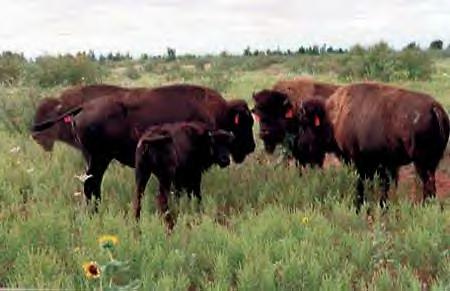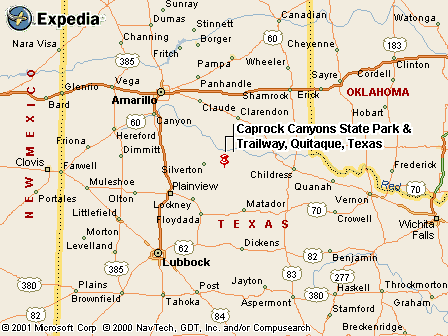|
|
Canku Ota |
|
|
(Many Paths) |
||
|
An Online Newsletter Celebrating Native America |
||
|
September 8, 2001 - Issue 44 |
||
|
|
||
|
Where the Buffaloes Roam |
||
|
Story and Photo by Rick Storm Amarillo Globe-News-September 2, 2001 |
 QUITAQUE -
Nine baby buffaloes bounce about Caprock Canyons State Park these days. QUITAQUE -
Nine baby buffaloes bounce about Caprock Canyons State Park these days."We thought we had eight, but we had one fool us and got a late calf," said Danny Sweptson, Texas Parks and Wildlife Department district manager. "It's hard to tell when they're pregnant." Sweptson said calving season lasts from the end of June to mid-September, with a nine- to 9-month gestation period. The buffaloes belong to the historic State Bison herd, which was started in the late 1870s when pioneer cattleman Charles Goodnight, sensing the demise of the great southern bison herd, roped two buffalo calves. "Goodnight had the foresight to preserve the herd," Sweptson said. "He also saw economic possibilities." Goodnight experimented with "cattalo," a cross between cattle and buffalo, until giving it up in 1917, Sweptson said. "Goodnight was unique among old-style cattlemen in that he'd experiment with other species," Sweptson said. The herd grew to as many as 250 and roamed free on the JA Ranch until 1997, when JA owners donated the herd to the state. The herd represents the only known genetically pure animals remaining from the great southern bison herd, once thought to have numbered more than 60 million head. The herd now numbers 40 - 18 males and 22 females, said C.L. Hawkins, TP&WD park ranger. Hawkins cares for the herd on a daily basis. This year marks an important year for the herd, Sweptson said, because one heifer calved that was only 2 months old when it was moved to the park from the ranch. In 2002, Sweptson said officials expect two heifers that were born at the park to become mothers. "Bison are 2 years old before they calf," Sweptson said. Sweptson said officials have drawn blood from each animal. "We are drawing up a genetic history of the herd," he said. "We will probably have the best genetic map of any herd in the U.S." The animals all sport ear tags and have been fully inoculated. The animals are carefully selected for breeding. Bulls are kept in a separate pasture. "We keep the big boys to themselves," Sweptson said. With a number of gangly yearlings now in the herd, officials feel a solid foundation exists for the herd to grow and thrive. And for the herd to thrive, Sweptson said officials face a number of challenges. "We wouldn't want to change them into a zoo herd," he said. "What we're trying to do is preserve the nature of the animal." The animals roamed unfettered on the ranch for about 120 years, and they now have about 360 acres of pasture. They aren't the docile animals typically found in a number of buffalo herds in the country, although they have calmed down somewhat. "The feed truck was both their downfall and their salvation," Sweptson said with a smile. "We got them used to the feed truck." Have the buffaloes attacked a truck or person? "The most trouble we've had is that one came up and licked the mirror of the truck," Sweptson said. Hawkins said one eager eater rocked the feed truck in an effort to get food to come down the chute after figuring out that feed fell out through the chute. And a bull recently suffered injuries after tussling with another bull. What does a fight between two buffalo bulls look like? "It was like watching one tornado hit another," Hawkins said. That's just one of many challenges officials face in trying to maintain the herd's natural state "An old boy told me that you can lead them 1,000 miles, but you can't push them 10 miles," Sweptson said. "And he's right. You work them on their time, not your time." Sweptson and Hawkins agreed that learning to work with the beasts was a hands-on learning experience. "If the day is right, you can pen them in a day; if the day is wrong, you might as well go dig post holes," Hawkins said. "I'll call Danny and say, 'I don't know what to do,' and he'll say, 'Well, I don't know what to do, either."' Both agree on one prescription for working with the animals. "The main thing is to keep it quiet," Hawkins said. The effort to preserve the integrity of the herd stems from the fact that the herd breaks down into a definite hierarchy, Sweptson said. "Buffalo are highly sociable animals," Sweptson said. "It's not unusual to see a grandmother taking care of a calf." And the bulls definitely have a pecking order. "It takes a bull four to six years before one's ready to challenge the big boys," Sweptson said. That can even lead to problems because sometimes the toughest bull is an older bull whose fertility rate has dropped somewhat. "They're a new challenge every day," Sweptson said. |
|
|
|
Caprock Canyons State Park |
|
|
||
|
|
||
| Canku Ota is a free Newsletter celebrating Native America, its traditions and accomplishments . We do not provide subscriber or visitor names to anyone. Some articles presented in Canku Ota may contain copyright material. We have received appropriate permissions for republishing any articles. Material appearing here is distributed without profit or monetary gain to those who have expressed an interest. This is in accordance with Title 17 U.S.C. section 107. | ||
|
Canku Ota is a copyright © 2000, 2001 of Vicki Lockard and Paul Barry. |
||
|
|
|
|
|
The "Canku Ota - A Newsletter Celebrating Native America" web site and its design is the |
||
|
Copyright © 1999, 2000, 2001 of Paul C. Barry. |
||
|
All Rights Reserved. |
||

